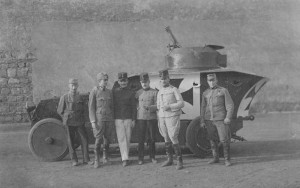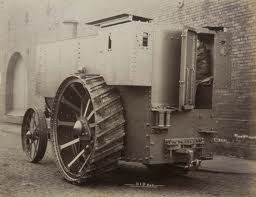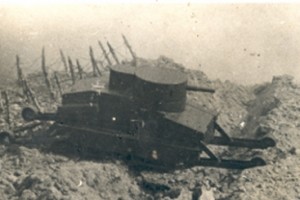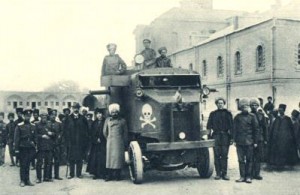TANKSgiving 2013 – Early Tanks
GrogHeads TANKSgiving
Author: Lloyd Sabin, November 26, 2013
Very Early Armored Vehicles
It’s the most wonderful time of year! When else do we get to discuss the benefits of century old armored oddities? Probably all the time if you’re a grog, but this is more special because we say it is.
Early motorized vehicles are fascinating enough…apply an inch of armor plate and a gun turret and it’s a real party. The below vehicles are some of my new found favorites…each has that certain something and they all look to have stormed straight out of a steampunk imagination. So put on your goggles, put a rag over your face and let’s see what all the kids are screaming about when they discuss very early armored vehicles. At least my kids, anyway.
Romfell Armored Car
 The Romfell was built in Austria-Hungary around 1915. That gives it a slightly exotic air. In 1915 and 1916, only two existed, but they both survived the harsh conditions and combat in the Balkans against the Serbian Army, and went on to engage the Italians and Russians. That gives it a tough reputation. In 1917 dozens more were built and deployed, its successful combat record making it somewhat of a legend.
The Romfell was built in Austria-Hungary around 1915. That gives it a slightly exotic air. In 1915 and 1916, only two existed, but they both survived the harsh conditions and combat in the Balkans against the Serbian Army, and went on to engage the Italians and Russians. That gives it a tough reputation. In 1917 dozens more were built and deployed, its successful combat record making it somewhat of a legend.
Each Romfell armored car had a crew of four, was powered by a Mercedes transmission and was armed with a Schwarloze machine gun that could be used against both air and ground targets. Reliable and fast for the era with a 26mph top speed, the Romfell is a popular vehicle for modelers.
It’s hard not to be intrigued by the Romfell. It’s very modern look, pedigree and durability guarantee that historians or car aficionados will quickly fall in love.
Fowler B5 Armored Locomotive
 Armored cars are one thing…armored trains are another.
Armored cars are one thing…armored trains are another.
Now don’t get the wrong idea, the Fowler B5 armored locomotive did not go into combat during the Boer War at high speed with guns blazing. It did, however, deliver heavy guns and supplies for the British Army against the Boers starting roughly towards the end of 1899.
To tow these guns, the Fowler factory in Leeds, UK, produced a handful of B5s with close to 125 horsepower! With that much strength, heavy slab armor was applied to the engines to protect them and their drivers from attacks by Boer raiders. Three or four of these heavy armored locomotives were used by the British during the Boer War, some with armored railroad cars as well.
Prototypes of gun carrying armored Fowler B5s were developed but as far as I could research, none were ever deployed in a combat role. It would have been quite the scene if they had been – there’s no telling how effective they would have been at fighting. For protecting and delivering heavy equipment and guns, though, they were very successful.
Motorgeschutz [Burstyn Tank]
 The Austrians had a knack for developing and creating new armored vehicle ideas seemingly from scratch. The Burstyn Tank or Motorgeschutz (rough translation “motor-vehicle gun”) was developed about ten years before the outbreak of the First World War, by Austrian Oberleutenant Gunther Burstyn, who was inspired by the new fast-attack torpedo boats that the Great Powers were testing for their growing navies at the turn of the last century. Burstyn tried to develop a land combat equivalent.
The Austrians had a knack for developing and creating new armored vehicle ideas seemingly from scratch. The Burstyn Tank or Motorgeschutz (rough translation “motor-vehicle gun”) was developed about ten years before the outbreak of the First World War, by Austrian Oberleutenant Gunther Burstyn, who was inspired by the new fast-attack torpedo boats that the Great Powers were testing for their growing navies at the turn of the last century. Burstyn tried to develop a land combat equivalent.
The Burstyn Tank was patented in 1911 and was extraordinary for its time, with a fully enclosed engine compartment to keep crew safe from engine fumes, a gun turret that could spin around almost completely, and mechanical lifts or arms at the front of the vehicle that the driver could use to pull the Motorgeschutz across trenches or other obstacles.
This small tank, ready for production in 1911 or 1912, was never produced because the design was so different from anything else that existed, and it was not produced even after war broke out. The accompanying image is a model set up to look like a working prototype, but from my simple internet research I found that there is only one life size model in an Austrian museum. The picture I included here is much more impressive, even if it’s just a small model!
Charron Armored Car
 The Charron Armored Car, to me, is fantastic.
The Charron Armored Car, to me, is fantastic.
One of the very first armored car designs, it was developed in Russia and accepted into French service in 1904. The first one was deployed by the French Army to Morocco that same year, and subsequent models were also used by the Russians to put down riots. It was successful in both roles for both countries.
Ten years later Charron armored cars were still in use at the outbreak of World War I, and were used by the French in 1914 to hunt down and destroy German observation balloons. The Germans also possibly had a couple of Charrons in service in their army in 1914. A total of 16 were built and deployed to Greece and the Ottoman Empire as well.
The Charron, like the Burstyn Tank, was very modern and innovative for its time of development in 1905. It was able to reach 30mph, an extraordinary speed considering it was fully encased in armor about 1/3 of an inch thick. It was recognizable for its single armored light mounted on the hood of the car, and came armed with a Hotchkiss machine gun in a rotatable turret. Some were even mounted with a 75mm anti-aircraft gun but this proved too heavy, and as far as I can tell, was not deployed.
The Charron was one of those vehicles that was not produced in great numbers but I get the feeling that the ones that were built were in service somehow, somewhere, for decades after they were built.
Putilov-Garford Armored Car
 The name Putilov-Garford may not be familiar, but once you see the picture you will recognize it. It was not a car at all but a beast of a truck.
The name Putilov-Garford may not be familiar, but once you see the picture you will recognize it. It was not a car at all but a beast of a truck.
A relative latecomer to this group, the Putilov-Garford was not developed until the First World War was on in the fall of 1914. The Garford components (engine, drivetrain and transmission) were actually American made by the Garford truck company in Ohio, and shipped to Imperial Russia where armor and armaments were added by Putilov.
These included a heavy machine gun in the rear of the truck as well as a cannon that could be turned slightly less than 180 degrees. A rear turret also carried a 75mm gun, and two Maxim guns were placed just behind the driver’s cab. The armor added to the truck was between 7mm and 9mm thick – that combined with the firepower saw the Putilov-Garford weigh in at about 22,000 pounds, or 11 tons. Due to the weight, the truck was not usable in open terrain and had to stick to decently-paved roads. But once it got going, this behemoth was almost unstoppable.
The Putilov-Garford was deployed throughout World War I by Russian forces and the Russian Civil War on all sides. It was successful in anti-infantry roles and in riots, as can be imagined, and was even successful against tanks in combat on occasion. A burly, imposing truck at 9 feet high and 19 feet long, it captures the imagination even if its design and load-out were a bit chaotic.
***
Look at this motley crew above…I dare you not to love each of these vehicles! Besides their exotic designs and smart good looks, many of them were innovators. Just imagine tearing down an obstacle in one of these, or speeding up a crowded street and blasting barricades out of your way…sheer groggy delight!
Happy Tanksgiving!
Discuss TANKSgiving in our forums >>



Leave a Reply